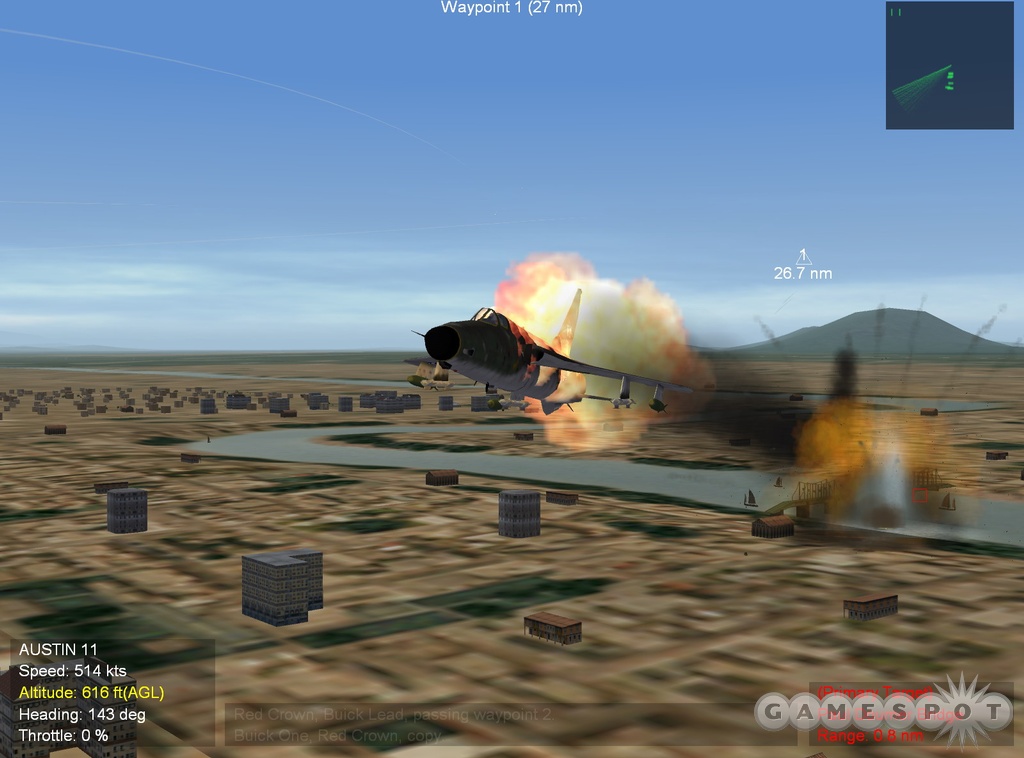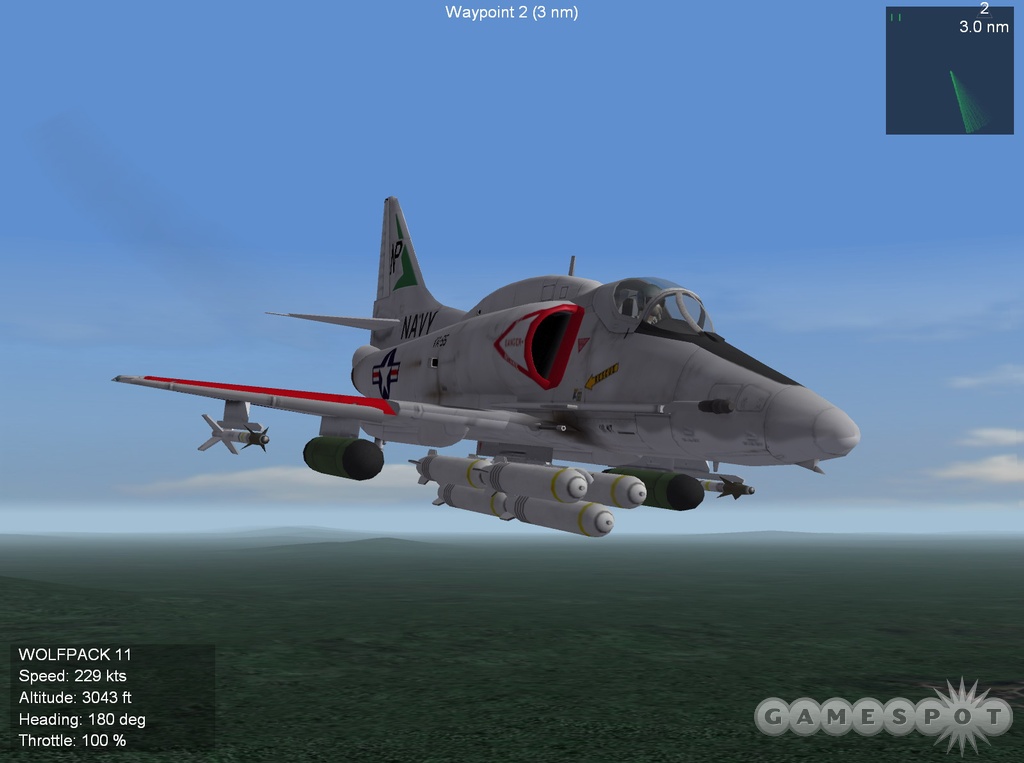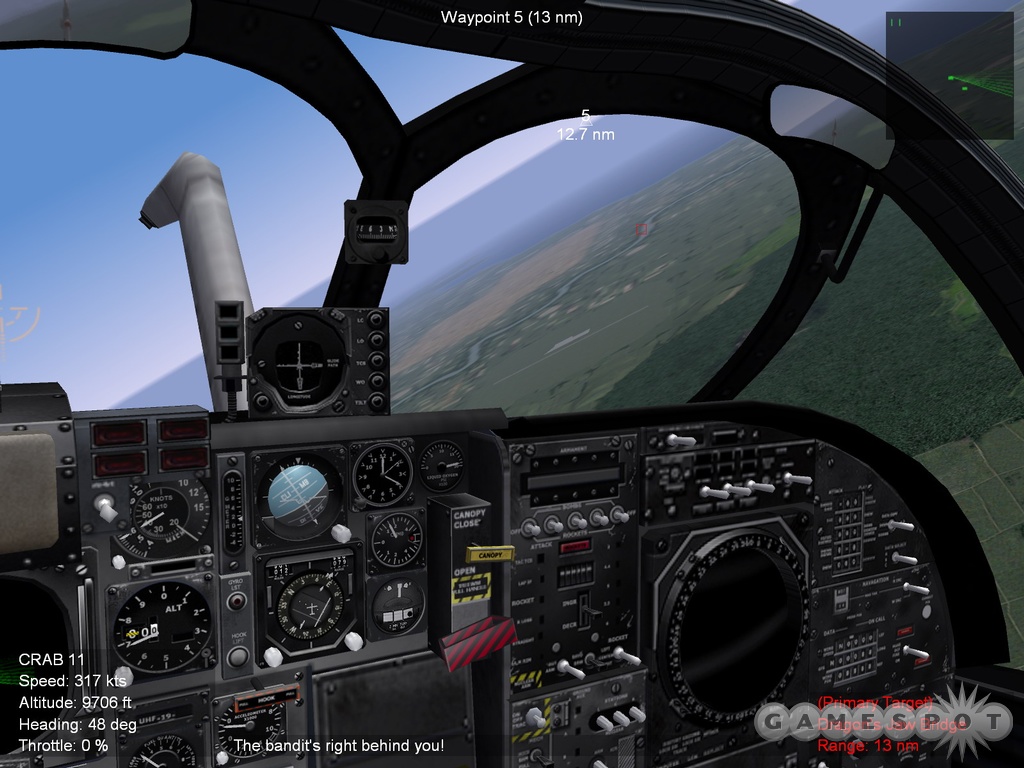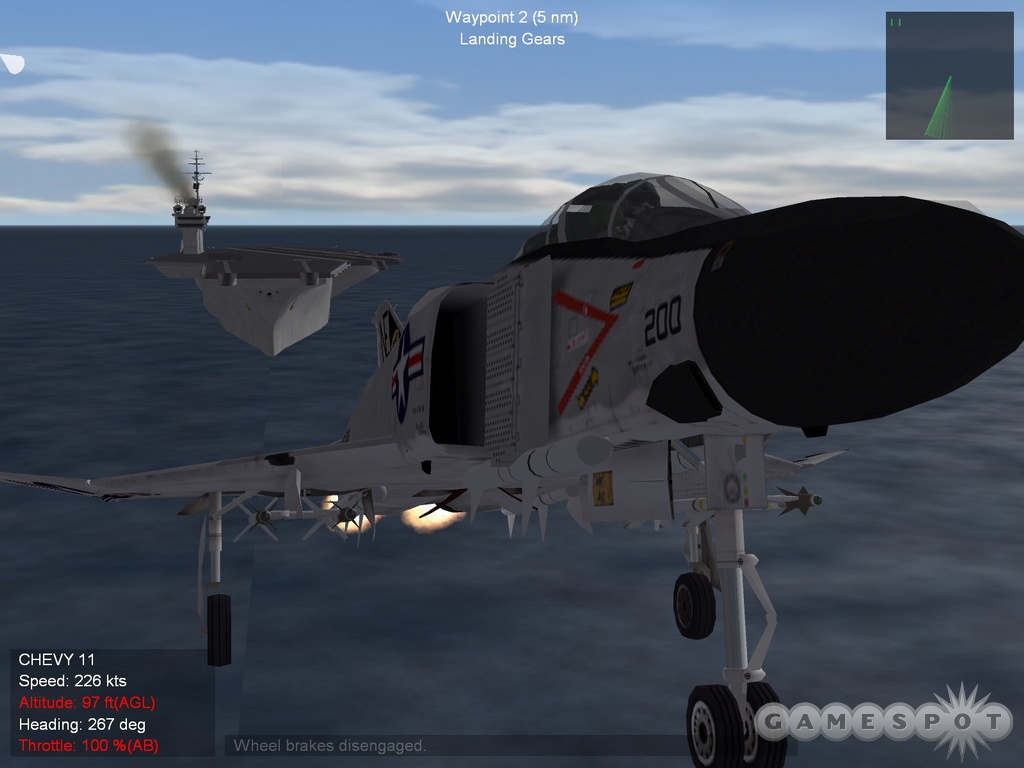The Vietnam War is a fascinating and underused setting for air combat simulations. Planes of the era were transitioning from subsonic and transonic fighters that relied mainly on guns to down other aircraft to extremely powerful and fast fighters like the F-4 Phantom that were built as missile-delivery platforms. These fledgling wonder weapons weren't nearly as effective as planners had anticipated, and American pilots had to face the dual threats of enemy aircraft that were designed for dogfighting and the most sophisticated network of antiaircraft defenses the world had ever seen. Wings Over Vietnam lets you experience much of the flavor of the conflict, but it's fraught with problems that can be very difficult to ignore.

A number of fighters and strike planes from the period are flyable, including several variants of the versatile F-4 Phantom II, nimble A-4 Skyhawks, ponderous A-6 Intruders, and the tough F-105 Thunderchief. Players also can climb into the cockpit of the obsolescent F-100 Super Sabre, the A-7 Corsair II, and the F-8E Crusader. Planes from the other side of the conflict sadly are not flyable, and while each plane's strengths and weaknesses are represented well overall, the flight models aren't exactly cutting edge. Planes can pull off extreme maneuvers that would turn real pilots into puddles of flesh from sustaining too many Gs, and some of the planes like the F-4 and F-8 are extremely difficult to stall no matter what crazy stick inputs you use. Pulling too many Gs causes a pilot to black out, but the plane still responds to stick input, making it possible to switch to an external view and continue with your extreme maneuvers. The drawback is that the plane bleeds off a lot of energy if you keep this up, but it still makes it possible to cheat by switching to an external view just long enough to line up a tricky shot. Quirks aside, each plane still works best in its intended role, and if you don't abuse the flight model, there's plenty of entertainment value in this package.
Three campaigns are included: Operation Rolling Thunder, Linebacker, and Linebacker II. They are dynamic, but the lack of mission variety makes it difficult to sustain interest. Each sortie begins at base, where players can arm their aircraft via an excellent loadout interface. With all of the realism settings enabled, setting up a plane so that it can properly strike its mission target, defend itself, and still have enough fuel to make it home is tricky, since it is often necessary to trade bombs for external fuel tanks. Air-to-air refueling unfortunately is not implemented.
Mission briefings are absurdly terse, and no information is provided about what weapons are best suited for the assigned task. This won't be a problem for Vietnam buffs who know better than to take 250-pound bombs to blow up the Dragon's Jaw bridge. It's the beginners that face a steep learning curve. Most missions involve multiple flights of aircraft, with fighters providing top cover for the strike planes. However, the briefings provide no information about the other types of planes involved in the mission.
In the air, dogfighting has its moments of intensity, but the computer-controlled pilots--both friends and foes--routinely make idiotic mistakes. F-4s tend to get into extended turning engagements with vastly more maneuverable MiGs, and they also tend to close to a very short range instead of engaging targets from miles away using radar-guided missiles. A few of the enemy planes we flew against were tenacious fighters, but most were glad to fly in perfectly straight lines as we fired missile after missile up their tailpipes, regardless of the difficulty settings that were chosen. Sim jockeys that are itching for a real fight will be relegated to playing in multiplayer mode, which relies on the HyperLobby matchmaking interface.
In the simulation, as in the historical situation, fledgling heat-seeking and radar-guided air-to-air missiles rarely live up to their published specifications, and much of the excitement in air-to-air combat involves setting up perfect launch parameters for a missile attack. With the radar-guided weapons this means identifying and targeting enemies from the maximum possible distance, waiting impatiently for the system to lock onto the target, and trying everything possible to maintain that lock until the missile hits its target. In the meantime, pressure from surface-to-air missiles (SAMs), antiaircraft fire, and other enemy aircraft make flying straight ahead and holding the lock a harrowing proposition.
Using heat-seeking missiles effectively means getting on an enemy's tail so the missile can lock onto the hot exhaust pipe, and when faced with opponents who put up a fight, that means a lot of tricky maneuvering. The seeker head in the missile growls constantly when the weapon is selected, and you must strain over all the other cockpit noise to hear the growl intensify, signifying that the seeker has found a target. The problem is that the missile rarely works if it is launched when you are pulling too many Gs, so in an intense dogfight the opportunities to take a shot that has a reasonable chance of hitting are fleeting.

Guns sap some of the fun out of dogfighting because they are immensely powerful. It takes only a few shells to obliterate a target, even when the guns are toned down to their most realistic setting, and even then, lining up a shot takes very little practice.
The opposite is true during ground strikes, where limited cockpit view settings and a lack of adjustable sights combine to make bomb drops a crapshoot. It doesn't take long to become fairly proficient at dive-bombing, but that's extremely dangerous in this game since it requires popping up above targets that are usually ringed by antiaircraft guns and SAM launchers. Level bombing at low altitudes and high speeds is much safer but nearly impossible without hours of practice.
Guns are extremely powerful during certain ground attack missions. They won't penetrate tank armor or take out a bridge, but during one mission where we were tasked with destroying a convoy of supply trucks, our trusty cannon demolished 23 of the hapless vehicles in a single firing pass. The other trucks blindly trundled on in a straight line and they were quickly finished off. This was all done without having to drop any of the cluster bombs dangling from our fuselage.

The game tracks an immense number of statistics, and at the end of the mission it's possible to see the precise time that you shot a particular weapon, what that weapon hit (if anything), and what hit you if your luck ran out. Medals also are awarded after missions if you've accomplished some appropriately heroic deeds or been unfortunate enough to earn a Purple Heart.
If you're not up for a full campaign there is an Instant Action option, which immediately flings you into a sky filled with enemies, or use the Single Mission option to access drop-down menus that let you quickly set up a customized sortie. We spent most of our time in this mode since it spits out the same types of missions generated in the campaign, but it let us select the aircraft we wanted to fly, the date, the mission type, and other parameters to keep things interesting.
One of the few things the campaign provides that the single missions do not is the chance to fly from and land on carriers, but it's no great loss. Carrier ops were obviously shoehorned in, as the massive ships don't move and don't have arresting wires. Instead, planes plop down on the deck and stick there as if the entire top of the ship is coated with industrial-strength flypaper.
Wings Over Vietnam is based on the Strike Fighters: Project 1 engine, and the graphics are better than those found in its predecessor, but not by much. Plane models are excellent, packed with little details like leading-edge slats that pop out of the Skyhawk's wings, and a great deal of research obviously went into the creation of aircraft markings and camouflage patterns. Unfortunately, all of the textures in the game are low-resolution, compared to other simulations like Pacific Fighters and Lock On: Modern Air Combat, so planes and cockpits don't look particularly good up close. Cockpits look particularly dated, with only a few key instruments being crisp enough to remain legible, while the rest of the cockpit looks blotchy and blocky in comparison.
The terrain varies a lot in elevation, ranging from undulating fields to relatively tall mountain ranges. This makes low-level strikes a blast, particularly at night when terrain-following radar must be employed. The terrain still looks extremely plain and there are no forests. Cities are represented by swaths of brown terrain dotted with small buildings, but it is impossible to collide with the structures, as planes simply pass right through them. The special effects are decent, and smoke and muzzle flashes from guns looks particularly good, but this certainly isn't the best-looking sim on the market.
Overall the audio is decent, with good explosion, engine, and weapon sounds, but everything is overshadowed by the awful radio chatter. Having the same voice screech "SAM launch, SAM launch!" repeatedly is annoying at best, and it is completely unhelpful in the game because it is rarely possible to tell whether they're talking about you or about some other plane five miles away.

Wings Over Vietnam's difficulty scales to accommodate nearly every skill level, and those who want the ultimate in realism will have their hands full just identifying and keeping track of targets. Newcomers can add all manner of helpful information to the heads-up display, and a skip-to-the-next-event feature lets them get to the action quickly. The major drawback for those who don't know much about the period is that there is no information on the planes in the manual or in the game, and there's very little information about the weapons you can carry and the weapons you'll face. Several premade single missions are included, for example, but there is absolutely no historical context provided to help players who haven't studied the conflict. When setting up a campaign you select a squadron from a pull-down menu instead of a plane, so if you have no clue what types of aircraft each unit flew, picking the right campaign is a matter of trial and error. Some users have reported unexpected crashes, although on our test hardware the game only crashed twice during our entire testing period, and we were unable to replicate the crashes by re-creating the circumstances that led up to them. A patch is already available for the game, but it was not installed for this review.
If you know enough or care enough to get past those shortcomings, put up with the game's various other foibles, and look past the dated graphics, there's a lot of fun to be had in this sim, particularly during ground attack missions. However, those who will only settle for the best in terms of flight model fidelity and cutting-edge graphics should let this one fly on by.